Nokia Lumia 630 Review
by Brett Howse on July 22, 2014 8:00 AM EST- Posted in
- Smartphones
- Microsoft
- Nokia
- Mobile
- windows phone
Display
The Lumia 630 display is surprisingly good, especially at this price point. Although not the brightest display around, it does have decent contrast due to good black levels. It also has the ClearBlack polarizer layer, which is a feature of many Lumia phones. ClearBlack uses linear polarizer and circular polarizer retardation layers between the phone and the display to attenuate reflections, much like polarized sunglasses work. The advantage is a less reflective display, which helps with outdoor readability.
The other part of outdoor readability though is a bright display, and here the results aren’t quite as good, with the Lumia 630 only able to achieve 330 nits at maximum brightness. I did find though that it was generally bright enough to use outdoors, however most smartphones have an ambient light sensor. The Lumia 630 does not, so that means that there is no auto-brightness control on this device, which means using it outdoors you have to manually adjust the brightness. Nokia has attempted to remedy this by including three preset brightness levels which are all infinitely adjustable, and one of the quick launch buttons in the action center is set as display brightness out of the box. For those keeping track – two of the four quick launch buttons of this device are set at the factory to overcome missing features from the phone.
The biggest negative with this display though is the resolution. 854x480 (the bottom 54 pixels are for the on-screen buttons) on a 4.5” display results in around 218 pixels per inch. Although this can be slightly forgiven due to the cost of this device, it’s definitely a drawback because you can clearly see the individual pixels on a display this size with that resolution. The competition from Android at around this price point is the Moto G, which sports a 1280x720 display and a much more impressive 329 ppi. The Moto E, which is slightly smaller at 4.3”, also packs in 960x540 pixels for 256 ppi. The Lumia 630 doesn’t live in a vacuum, and 800x480 effective resolution is just too low.
One other complaint with the display before we move on to color testing is that the Gorilla Glass has an almost matte texture to it, and I found in my time with the device that it attracts fingerprints much more easily than other phones I’ve used, including the 620 from last year. It’s somewhat annoying, but not something that really bothered me, it’s just noticeable.
To test the display accuracy, we turn to Spectralcal’s CalMAN 5 software package with a custom workflow. We utilize the X-Rite i1Pro Spectrophotometer for color accuracy and saturation, and the X-Rite i1Display Pro for contrast ratios. First up is brightness and contrast, which we’ve touched on earlier.
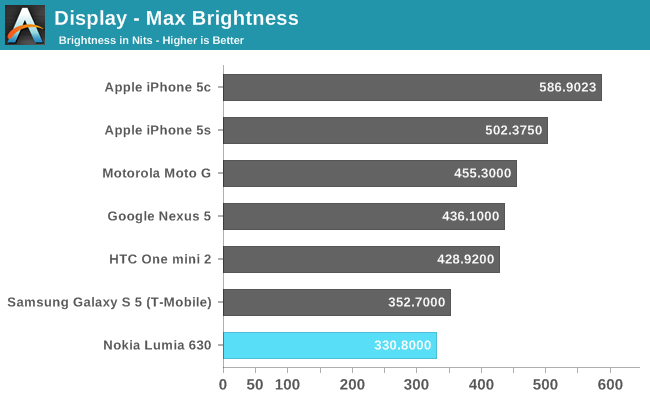
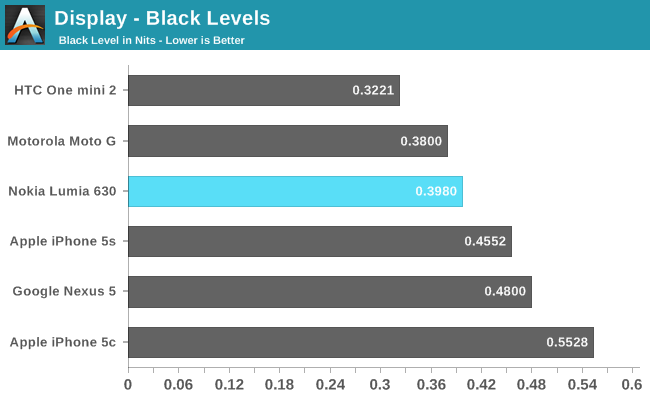
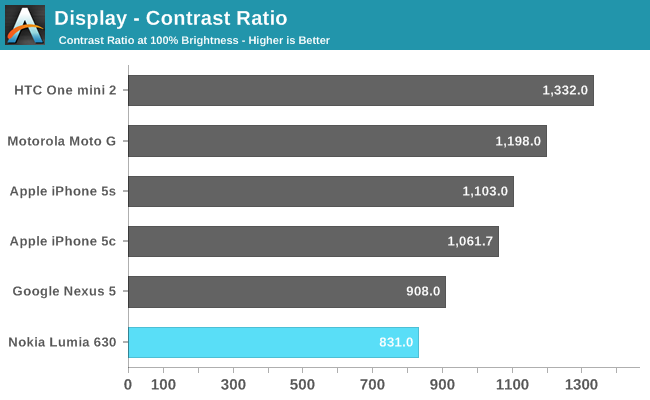
The overall contrast ratio is let down by the lack of a powerful backlight. At the minimum backlight level, the contrast ratio jumps way up to 1500:1. This display is once again bumping into the fact that this phone has competition at this price point, and screen brightness is once again a bit of a let down, but with the ClearBlack system, outdoor readability is still decent.
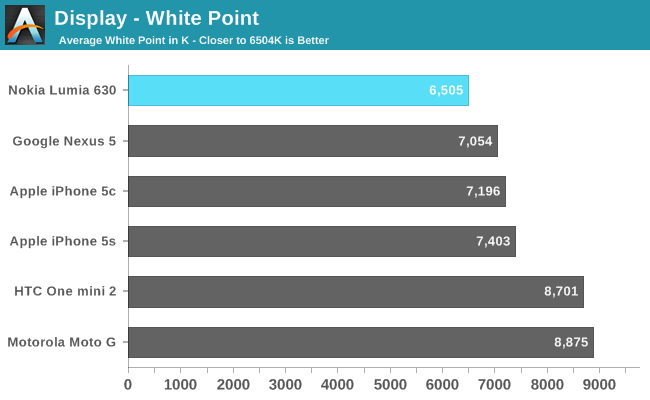
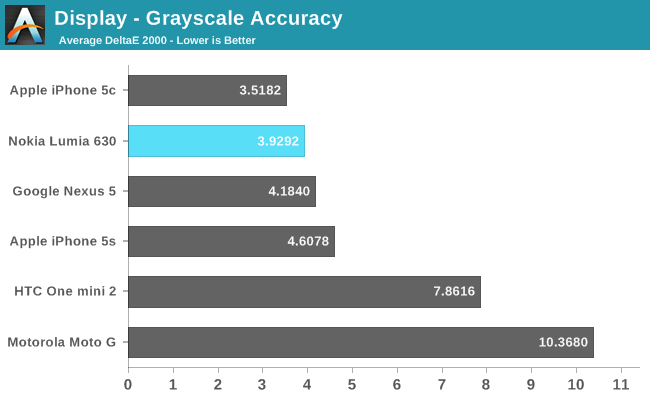
White Point is almost dead on at 6505, but the display is lacking some green. For this reason, you can’t ever just look at color temperature for white and know the whole story. Red is also a bit strong, but overall the grayscale average is quite good for a smartphone, coming in close to the top for grayscale and right at the top for white point. It’s a great start for a low cost phone. Please note that the contrast ratio in the screen capture is not accurate due to the i1Pro not having accurate low light measurements. Let’s continue on and check the color accuracy and saturation sweeps.
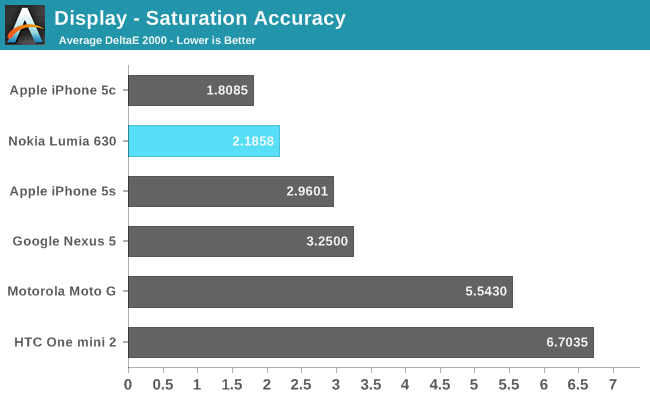
This display is fantastic here, outperforming even the iPhone 5S. While some phones seem to love to oversaturate colors to draw in perspective buyers at the store, the Lumia 630 keeps them almost perfect. If you do prefer to adjust the saturations, you can do that in the display options, but I found that moving them up or down was too drastic of a result, especially when the default setting is almost perfect.
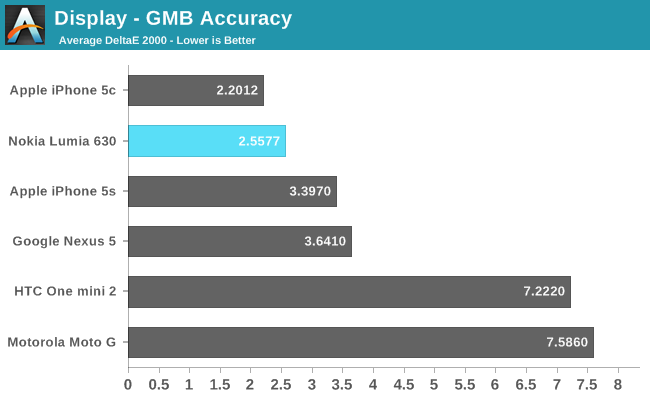
Once again, we have an excellent result in the colorchecker, and once again the Lumia 630 beats out the iPhone 5S for overall accuracy. That’s a pretty fantastic result for a device of this cost. What drives up the average is the relatively poor greyscale performance and the lack of green in the whites, which comes through in the overall rating. You may notice a slightly different chart here than other smartphones, but it’s the same chart just with more colors checked.
I have to commend Nokia on the accuracy of this display out of the box. It’s also important to note that this is the first Lumia (at least that I’ve seen) that has both a brightness slider, and adjustable saturation levels.


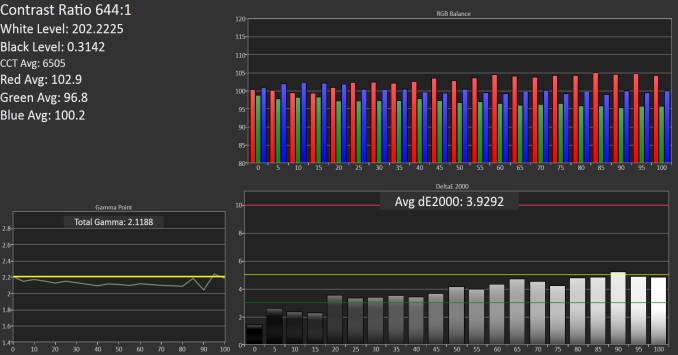










83 Comments
View All Comments
kspirit - Tuesday, July 22, 2014 - link
Incredibly detailed and excellent as usual. Thanks for all the info. I'm glad you clarified why the 930 doesn't have Glance. It confused me, because I thought it was something MS was killing off with WP8.1. Good to know that's not the case.kspirit - Tuesday, July 22, 2014 - link
Another thing I'd like to add is that the 630's display is not "real" ClearBlack. I have seen and owned devices with those, and my father has a 630, and this is most certainly NOT a CBD. It's marketed as such but there is no polarizer.DanNeely - Tuesday, July 22, 2014 - link
"But again the storage of only 8 GB is no problem at all due to the included microSD card being able to add another 128 GB if needed, and Windows Phone 8.1 supports SD cards better than any other mobile OS."Having ran into one major performance problem with using the SD slot on my WP8/8.1 phone, I don't know how true this is in general. Earlier this year I bought a 520 to play around with WP8 and to use as a music player when the risk of breaking it was high enough that I didn't want anything expensive.
My music collection is currently ~60GB/11,000 tracks so I figured that with a 64GB uSD card (class 10) I'd be able to load everything on the sdcard and be good to go. Unfortunately I found that wasn't the case. I often shuffle over my entire music collection instead of drilling down to a specific artist/album. This turned out to be a major problem on my 520.
With the original WP8.0 install attempting to do so froze the phone completely for between 5 and 15 minutes before returning to normal operation mode (at this point everything worked perfectly unless I restarted the phone or changed to a short playlist and then tried to go back to the long one). This problem affected XBox Music, Nokia Music and a few free players I found so it appears to be OS related. I tried upgrading to the developer preview build of WP8.1. This fixed the total phone lockup, but gave a new problem. With the giant playlist there is an ~30s delay between pressing next/previous song and the song being played changing.
With both OS versions this wasn't a problem with small play lists on the SD card or when playing back from internal flash (limited to shorter play lists due to lack of space).
I don't know if this is a problem with the SD implementation in particular, I'm using a class10 card so my card itself shouldn't be the problem, or due to the total size of the playlist swamping the CPU somewhere. I haven't tried filling the card up most of the way with images or video to see how well those apps behave; but this has left me rather skeptical of WP8's ability to effectively use a large SD card to replace internal storage.
silverblue - Tuesday, July 22, 2014 - link
I'm not sure but it may be scanning all your music upon starting the app.DanNeely - Tuesday, July 22, 2014 - link
I don't think so. The app launches as quickly as anything else on the phone does, and WP8 refuses to identify music/etc unless synced using an official app (vs just copied via explorer); and lists everything in the various category based lists (artist/genre/etc). The genre/etc based lists aren't possible without a full index already existing since (unlike artist) they can't be inferred from the file system.In 8.0, it was clearly doing some sort of pre-processing step before starting playback (but completely freezing the phone to the point of even hardware buttons being non-responsive is totally unacceptable); 8.1 doesn't do that, but has a major runtime performance problem as a result.
Kit Y - Tuesday, July 22, 2014 - link
DanNeely is definitely right on this issue, Windows Phone 8.1 removed the on board music and videos to Xbox Music/Video that is separated from the core platform to allow more timely updates to the music player.However, the current music player do suffer from a lot of bugs and slowdown as reported on r/WindowsPhone quite often and major compliant of many uses.
If I had the choice to make decision to balance cost and the features, I would forgo 4GBs of on board storage in exchange of ambient light sensor and 1GB of RAM, GG3 for Glance Screen and perhaps rename it to 530 as it seems to be a lot more appropriate given it's limitations and the similar launch price of 520 which we should see it to be drop to under $100 in many markets.
DanNeely - Tuesday, July 22, 2014 - link
I haven't tried any 3rd party players with 8.1; do you know if the architectural changes provide any scope for 3rd party players to preform better than Microsoft's?althaz - Tuesday, July 22, 2014 - link
The music app is currently being updated pretty regularly and is a LOT better today than it was a month ago.That said, there's plenty of scope for a developer to make a much faster app - I'm working on one at the moment. My plan is to make something pretty limited, but I would personally prefer a very basic app that's fast over one that is fully featured but slower.
skiboysteve - Tuesday, July 22, 2014 - link
the latest version of xbox music on WP8.1 resolves this exact issue. it now no longer scans for entire folders for music file changes every start up... it must use some indexing thing now. It also does scanning and updating in background if you're on wifi and plugged inAlexvrb - Tuesday, July 22, 2014 - link
Yeah they've been making some improvements on the latest updates. Overall the memory card support in WP 8.1 is great.As far as "Class 10" goes... it's almost a meaningless label. Even having a UHS-I rated card doesn't really tell you much. Unless you have read/write and IOPs figures for the memory card in question, it might as well be labeled "random flash card that I hope doesn't blow". I have an ADATA UHS-I microSD card that is rated at 1400/100 IOPs random read/write. Most card manufacturers don't even release those specs because they are so bad.
I really hope UHS-II picks up steam and they start releasing mSD variants and devices that support it. I've seen some UHS-II SD cards with IOPs twice as high as my card or better.